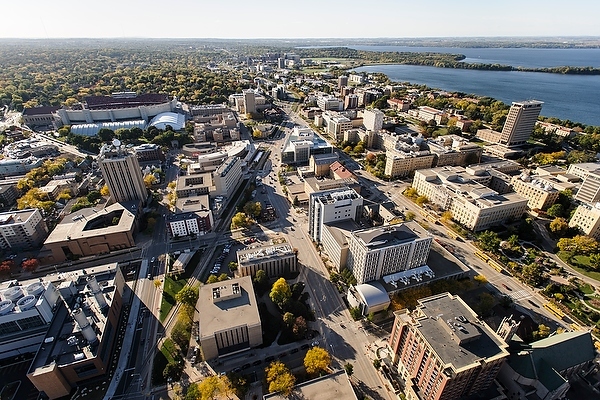Heat waves hit heat islands hardest

This heavily paved central campus area of the University of Wisconsin–Madison is characteristic of urban heat islands, in which densely built parts of a city retain heat more than their nonurban surroundings.
Extreme summers like that of 2012 — which saw record temperatures in cities across the U.S. — may be atypical, but experts say they will return, especially as the planet warms under climate change. And as they do, cities will be especially vulnerable.
A new University of Wisconsin–Madison study details how extreme temperatures affect urban heat islands — densely built areas where heat-retaining asphalt, brick and concrete make things hotter than their nonurban surroundings.
The study, published last week in the journal Environmental Research Letters, found heat waves hit urban areas hardest, shedding light on what a future with more extreme summers might mean for the world’s growing population of urbanites.

Jason Schatz
Since heat islands tend to be the most densely populated areas of the city, as the chances of a heat wave rise, many city-dwellers could face more uncomfortable summers, increased health risks and potentially higher energy bills from air conditioning.
“Not only do heat waves intensify the urban heat island, but the heat island also intensifies the heat wave, which is pretty much the opposite of what you’d want,” says the study’s lead author, Jason Schatz, a postdoctoral researcher on the Water Sustainability and Climate Project at UW–Madison.
By nature, extremes are rare. But Schatz got a stroke of luck when, within the first three years of the study, their study site and Wisconsin’s capital city, Madison, was hit with both the 2012 heat wave and the polar vortex of 2013-14, which caused the coldest winter in 35 years.
Using data from the 150 sensors Schatz installed in and around Madison, the researchers found that urban areas experienced up to twice as many hours over 90 degrees Fahrenheit than rural areas during the 2012 heat wave.
The densest urban areas also spent over four consecutive nights in temperatures above 80, the National Weather Service‘s nighttime heat advisory threshold. Since prolonged heat exposure, rather than isolated hot days, is what can cause heat stress, long stretches with no nighttime reprieve in densely populated areas pose a greater risk to public health.
“Not only do heat waves intensify the urban heat island, but the heat island also intensifies the heat wave, which is pretty much the opposite of what you’d want.”
Jason Schatz
This risk is bound to grow if cities don’t plan accordingly, warns co-author Chris Kucharik, a professor in the Department of Agronomy and the Nelson Institute for Environmental Studies.
“2012 is pretty representative of summers we are likely to experience 50 years from now,” he says.
Climate change projections from the Wisconsin Initiative on Climate Change Impacts indicate Madison could experience an average of 29 to 37 days above 90 degrees by the middle of this century, compared to the current average of 9 days. Yet these projections don’t account for urban heat island effects, upon which Schatz casts concern.
“Cities are where most people will encounter future warming, and projections are underestimating the amount of heat urban communities need to prepare for,” he says.
It’s not just climate change projections that underestimate the effects of the urban heat island, Schatz says. Madison’s only National Weather Service station, located at the Dane County Regional Airport, is also undershooting.
The airport recorded 39 days over 90 degrees in 2012, but the data Schatz collected indicated downtown Madison experienced upwards of 49 days over 90.
“The airport is in a low-lying, swampy area, which isn’t representative of where most of Madison’s population lives,” says Schatz.
On the flip side, the heat island could make urban life a little easier when temperatures dive to the other end of the thermometer.
On the flip side, the heat island could make urban life a little easier when temperatures dive to the other end of the thermometer. During the polar vortex, Madison’s heat islanders experienced as many as 40 percent fewer hours of exposure to below-zero temperatures, making it slightly less miserable on both their bodies and heating bills.
Cold snaps of this magnitude are less likely to happen as Wisconsin warms, but Schatz says understanding what they do to the urban climate is still important.
“This is Wisconsin. Cold weather still happens,” he says.
The study builds on a 2014 paper from Schatz and Kucharik in the Journal of Applied Meteorology and Climatology describing the seasonal behavior of Madison’s urban heat island. Their research is supported by the Water Sustainability and Climate project, a research endeavor funded by the National Science Foundation.
—Jenny Seifert
Tags: climate change, environment, sustainability, weather




